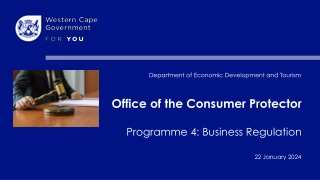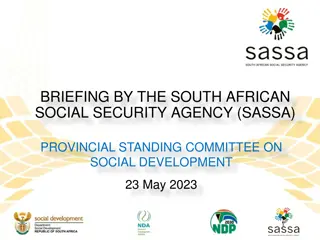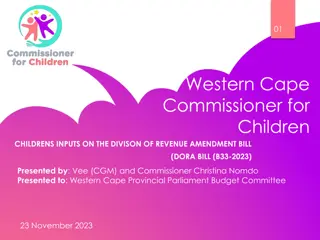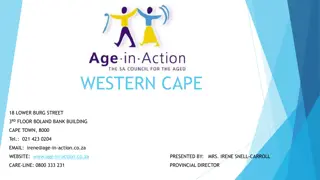Child Death Review Project in Western Cape
The Child Death Review Project presented by Prof. Shanaaz Mathews focuses on child murders in the Western Cape region, aiming to address the high child homicide rates and improve coordination between health, police, and social services to prevent further child deaths. By developing intersectoral responses and utilizing multidisciplinary teams, the project seeks to clarify causes of death, identify preventable factors, and recommend improvements in health and child protection systems.
Download Presentation

Please find below an Image/Link to download the presentation.
The content on the website is provided AS IS for your information and personal use only. It may not be sold, licensed, or shared on other websites without obtaining consent from the author. Download presentation by click this link. If you encounter any issues during the download, it is possible that the publisher has removed the file from their server.
E N D
Presentation Transcript
The Child Death Review Project: Child murders in the Western Cape Presented by Prof Shanaaz Mathews Director Children s Institute University of Cape Town
Core CDR Team Prof Shanaaz Mathews Children s Institute, UCT Prof Lorna Martin Division of Forensic Medicine, UCT Adv Bonnie Currie-Gamwo Deputy Director of Public Prosecutions, Western Cape: NPA Capt Renier Cloete, WC SAPS Provincial Ms Erna Morden Health Impact Assessment WC DoH Dr Natasha Rhoda Paediatrician, Groote Schuur Hospital Ms Linda Notnagel Provincial DSD
CDR team leads across the province Salt River Team Prof Lorna Martin Tygerberg Team Dr Johan Dempers Winelands Team Dr Deidre Abrahams Worcester Team Dr Denise Lourens George Team Dr Christa Hattingh
Background to the CDR Project 1018 children were murdered in 2009 1 Child murder rate 5.5/100 000 children under 18 years 45% of children killed in the context of child abuse and neglect Almost (74%) of fatal child abuse cases - under 5 years Child homicides are a low priority for police Lack of co-ordination between health, police and social services compromised the outcome of management of child abuse deaths 1 Mathews S, Abrahams N, Jewkes R , Martin L J., Lombard C. 2013. The Epidemiology of Child Homicides in South Africa. Bulletin of WHO. 91:562 568.
Developing an intersectoral response to child deaths
CDR Process Goals Goals Scope Methods Methods Focus on: *Clarifying cause of death Discuss what events led to the child s death (medical history and police investigation) Identify if additional information is required Establish whether the death was avoidable Identify potential preventable/remedial factors Development of a multi- disciplinary team 1. How and why deaths occur Monthly team meetings 2. Potential remedial factors Reviewed all child deaths (under 18 yrs) at both sites through a standardised set of questions 3. Recommend health and child protection systems improvements to prevent further child deaths 4. Is a multi-agency approach feasible in RSA? Forensic pathologist played a leading role in the review Mathews S, Martin L, Coetzee D, Scott, C, Naidoo T, Brijmohun Y & Quarrie K. 2016. The South African child death review pilot: a multi- agency approach to strengthen healthcare and protection for children. SAMJ. 106(9), 895-899.
Cases reviewed by the Western Cape CDR teams in 2018 N = 1594 Undetermined 12% Suicide 2% Accident 16% Murder 20% Natural 50%
Defining Child Murder Child Murder unnatural death of child under the age of 18 years for which another person is responsible This includes gang violence, fatal child abuse, peer on peer interpersonal violence, community violence Child Murder related to child abuse and neglect - all forms of physical, sexual abuse, neglect or negligent treatment resulting in the child s death, in the context of a relationship of responsibility and care. Infanticide - killing of a child under 1 year (infant) we include where the infant is killed deliberately. This includes : Abandoned baby - when an infant is left or deserted without care Live Birth evidence that child had breathed post birth
30 95 33 18
Pattern of child murder by age and sex Salt River Mortuary (N = 95) 60 Male 50 Female 40 Number of Cases 30 53 20 10 17 14 5 5 1 0 < 5 years 5 - 12 years 13-17 years Age of Victim
Pattern of child murder by age and sex Tygerberg Mortuary (N = 123) 90 Male 80 Female 70 Unknown 60 Number of Cases 50 40 79 30 20 10 17 11 5 2 5 0 4 0 0 < 5 years 5 - 12 years Age of Victim 13-17 years
Type of Murder by Age Salt River Mortuary (N = 95) 40 < 5 years 35 5-12 years Young men most likely due to gangs and interpersonal conflict 30 1 0 13 - 17 years Child abuse deaths most prevalent under 5 years 25 Number of Cases 35 20 15 26 10 17 5 0 2 1 4 2 3 2 0 1 0 1 0 0 0 Parent/s Relative interpersonal Gang Violence Community Violence Taxi Violence Type of Murder
Child Murder - Top 10 police station The City of Cape Town Police Station Number of cases Delft 18 Mfuleni 17 Gugulethu 15 Harare 12 Kraaifontein 11 Phillipi / east 11 Nyanga 10 Khayelitsha 9 Mitchells Plain 9 Ravensmead 9
Pattern of fatal child abuse in South Africa Incidence of fatal child abuse highest in the first year of life1 As children get older the risk of being killed by a mother decreases The role of men, in particular the mother s partner and relatives/ known men to the child take on prominent role in the murder of children in the murder of both girl and boy children One in 10 child murders are associated with rape mainly perpetrated by a known male and mainly a problem affecting girls 2 1. Abrahams N, Mathews S, Martin LJ, et al (2016) Gender Differences in Homicide of Neonates, Infants, and Children under 5 y in South Africa: Results from the Cross-Sectional 2009 National Child Homicide Study. PLoS Medicine, 13, e1002003 2. Abrahams N, Mathews S, Martin LJ, et al. (2017). Sexual homicides in South Africa: a national study of adult females and children. PLoS ONE 12(10): e0186432. https://doi. org/10.1371/journal.pone.0186432
Murder of young men Large numbers of young men are killed yearly Gang violence and interpersonal (peer on peer violence) are the major risks facing young men Driven by social norms promoting the use of violence Availability of weapons particularly guns increase the lethality of altercations (stricter gun control is critical) Alcohol and drug use and abuse fuel violence
Positive Criminal Justice Outcomes National Prosecuting Authority (NPA) prioritised child murders since the start of the CDR process Senior officials represent the NPA at all the CDR sites Police investigation guided by the NPA and prioritised much earlier than before- this is the new normal Prosecutorial decisions taken sooner Speedy finalization of child death matters
conti Child murders are speedily identified despite being registered as inquests by SAPS Investigation managed and prosecution in the High Court prioritised High conviction rate Positive media coverage
Potential modifiable factors Social and psychological support of pregnant mothers assessment of vulnerability Parental drug and alcohol abuse was found to be associated in large numbers of child deaths Violence in the home extend its impact on children and increase risk for exposure to abuse and also death High levels of sexual violence fuel the burden of rape- murder among children, particularly girls need to addressed Building children s conflict management skills is imperative to reduce peer on peer violence
Using the CDR process and data to reduce child murders Data can be used to identify hotspot to target interventions for families and children Modifiable factors identified through the CDR process can inform strategies for prevention Training workshops with child protection social workers to understand risk of remaining children in families Real time response from SAPS and NPA to improve criminal justice outcomes and speedily conclude cases to endure perpetrators are held accountable























